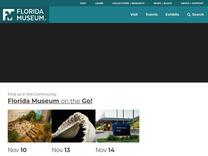Enhydritherium terraenovae – Florida Vertebrate Fossils https://www.floridamuseum.ufl.edu/florida-vertebrate-fossils/species/enhydritherium-terraenovae/
Quick Facts Common Name: none Enhydritherium terraenovae is a large, extinct otter capable of living in both freshwater and coastal marine habitats. A nearly complete skeleton is on permanent public display at the Florida Museum of Natural History. It was collected at the Moss Acres Racetrack
This led Lambert (1997) to conclude that these fish bones were the stomach contents

